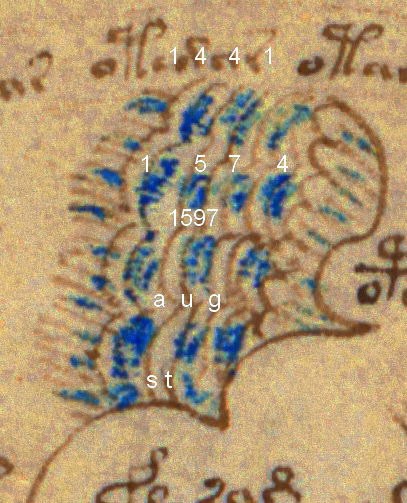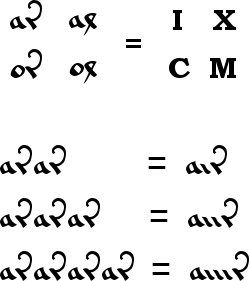Fifteen hours in the air coming back from Taiwan (even if it was ultimately to the wrong airport) does lead you to click through all (and I really do mean all) the listings on China Airlines’ seatback audio/video on demand gizmo. And so it was that I listened to Eminem’s 2009 album Relapse (Bagpipes in Baghdad, etc), and watched not only Avatar (hi-tech pants, but all the better for not being in 3d), Shakespeare in Love (Gwyneth Paltrow gains a moustache, Shakespeare loses a muse, the end)… but also a rather splendid documentary on Jesuit missionary Johann Adam Schall von Bell (1591-1666).
[No, he didn’t write the VMs (nor the Rohonc Codex): but he was in Rome between 1611 and 1618, so there is an outside chance that he met Georg Baresch, who started at La Sapienza in 1605, Voynich trivia fans.]
It was the Jesuit mathematician and cartographer Matteo Ricci (1552-1610, so note that 11th May 2010 will mark the 400th anniversary of his death) who made the first real breakthrough into mainland China: as a result of his long-term efforts in understanding Chinese language, writing and culture, he became the first Westerner allowed into the Forbidden City (though he never actually met the Emperor). He co-compiled the first Westernized Chinese dictionary (around 1583-1588, though it got lost in the Jesuit archives until 1934) as well as the second one (1598, this time round with diacritical marks, but this one has yet to surface), and the first European-style map of the world in Chinese (in 1584, but only six copies of the 1602 printing survive). A pretty impressive set of cultural landmarks.
According to this interesting paper by Zhang Baichun:
“Ricci was the first to introduce European astronomical instruments to the Chinese. He made a copper celestial globe in Zhaoqing 肇 慶 (Guangdong) and explained astronomy to visitors in the 1580s. He also taught students in Shaozhou 韶 州 (Guangdong), Nanking, and Peking how to make a celestial globe, an astrolabe, a quadrant, and a sundial. In 1605, Ricci and Li Zhizao 李 之 藻 (1565-1630) wrote the Qiankun tiyi 乾 坤 體 義 (Cosmological epitome), describing the use of a copper armillary sphere to demonstrate the relation between the heavens and earth and to help calculate the coordinates of the celestial bodies (fig. 1). Two years later, Ricci and Li explained the astrolabe and its method of coordinate projection in another work, the Hungai tongxian tushuo 渾 蓋 通 憲 圖 說 (Explanation of the coordinates of the celestial sphere and vault). Prior to this, the demonstrational armillary sphere, the quadrant, and the astrolabe were unknown in China.”
Matteo Ricci tried to determine eclipses, but this was the limit of his abilities: and so noted that a future Jesuit approach to China should include missionaries who were able to construct accurate planetary calendars.
In many ways, calendar-making was a huge political problem in China: the practice had long been for a calendar to be set up at the start of a new dynasty, but this had the downside that over time its usefulness would slip and slide, causing faith in the Emperor (and indeed in the whole ruling class) to recede. For if the Emperor could not predict eclipses, what kind of control did he have over the universe? In fact, you could argue that this specifically Chinese calendrical drift was one of the key factors that helped drive the (vaguely Spengleresque) changes in dynasty.
This was essentially why Johann Terrenz Schreck (did he have a son called Shreck Two?), Giacomo Rho and Johann Adam Schall arrived in Macau in 1619. They came in ships laden with 7000 volumes containing a vast amount of up-to-the-minute Western scientific knowledge, plus numerous trendy and useful technical instruments (such as telescopes): yet the journey aboard their year-long, ummm, slow boat to China had been harrowing, and only six of the crew made it all the way.
The immediate problem they faced was that, after Matteo Ricci’s death in 1610, the Jesuits in Macau weren’t actually welcome on the mainland. However, after a few years this situation was (somewhat curiously) turned around by a war breaking out: Adam Schall compiled a book in Chinese on the latest European war machines (such as cannons) to advise the ruling Ming dynasty, and all of a sudden doors opened to the Jesuits once more.
Later (between 1631 and 1635), Adam Schall helped compile the 137-chapter “Chongzhen Calendar”, which applied the European learning the missionaries had brought with them to the problem of constructing a truly Chinese calendar. However, Emperor Chongzhen decided not to use it: the Ming Dynasty was in huge difficulties, and he judged that introducing it would have added more difficulties to the (already long) list. When the dynasty finally fell and the new Qing Dynasty began, Adam Schall bravely decided to stay on in Beijing – and (after some hair-raising troubles) became a close confidant of the newly installed Shunzhi Emperor. The calendar he had helped construct for the Ming Dynasty was finally introduced by the Qing Dynasty, and remained in use for hundreds of years afterwards.
[Of course, Adam Schall died fairly unhappy because he had failed to convert many people to Christianity, which ultimately had been the whole point of the expensive exercise. But let’s not dwell on that.]
* * * * * *
As far as assessing VMs “Chinese” theories goes, I learnt a great deal from all this. For one, Chinese astronomy of the day had long been based around dividing the equatorial sky in 365 and 1/4 divisions, and the Jesuits had difficulty transitioning over the instruments that were being made to use a somewhat less laborious 360 degree division: so I’m somewhat skeptical that the 30 x 12 = 360 nymphs/stars/labels of the VMs’ zodiac pages can have anything at all to do with Chinese astronomy pre-1640 or so.
I’m also now extremely skeptical about any Voynich Chinese language theory (and, yes, I was already pretty skeptical beforehand – after all, Jacques Guy had originally proposed the notion as a froggily linguistic canard). Socially and culturally, creating any kind of multi-letter Romanized transcription of Chinese or other similarly languages would be a major undertaking that would have attracted great attention. The idea that this could have been done on the quiet (and solely for the VMs) just seems flat-out wrong, particularly if you date the VMs to well before Matteo Ricci’s 1583-1588 first dictionary.
Furthermore, it was fascinating to read in Zhang Baichun’s article that even though (back in Europe) Johann Hevelius had telescopes, he used other equipment and naked-eye obervations in preference to them: citing Hepsold (1908), he notes that “In 1679, Hevelius and Halley had made comparative observations in Danzig. The results showed that the data obtained by Halley with the telescope were not more precise than those obtained by Hevelius with his own sights.” Telescopes, even by the mid 17th century, were still generally very poor quality.
Of course, you’re entirely free to make up your own mind on the origins of the VMs – but personally, I simply don’t see anything Chinese there whatsoever.

